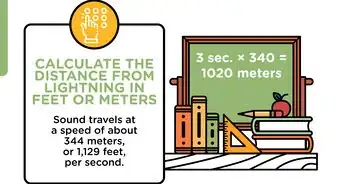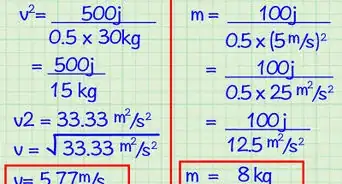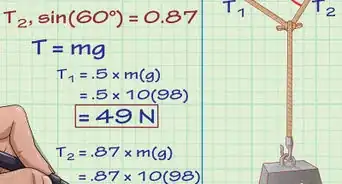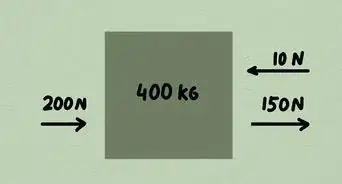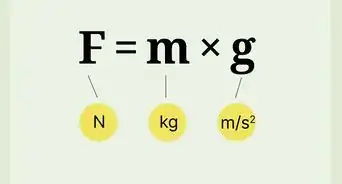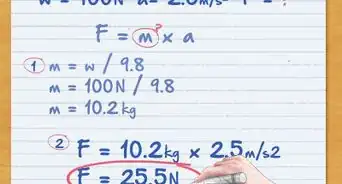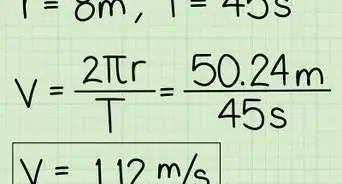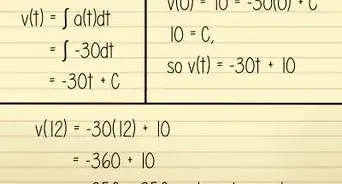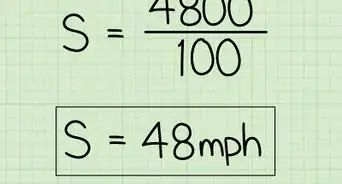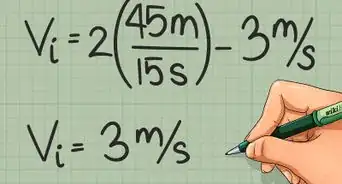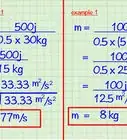wikiHow is a “wiki,” similar to Wikipedia, which means that many of our articles are co-written by multiple authors. To create this article, 25 people, some anonymous, worked to edit and improve it over time.
There are 7 references cited in this article, which can be found at the bottom of the page.
wikiHow marks an article as reader-approved once it receives enough positive feedback. In this case, several readers have written to tell us that this article was helpful to them, earning it our reader-approved status.
This article has been viewed 309,303 times.
Learn more...
The escape velocity is the velocity necessary for an object to overcome the gravitational pull of the planet that object is on. For example, a rocket going into space needs to reach the escape velocity in order to make it off Earth and get into space.
Steps
Understanding Escape Velocity
-
1Define escape velocity. Escape velocity is the velocity of an object required to overcome the gravitational pull of the planet that object is on to escape into space. A larger planet has more mass and requires a much greater escape velocity than a smaller planet with less mass.[1]
-
2Begin with conservation of energy. Conservation of energy states that the total energy of an isolated system remains unchanged. In the derivation below, we will work with an Earth-rocket system and assume that this system is isolated.[2]
- In conservation of energy, we equate the initial and final potential and kinetic energies where is kinetic energy and is potential energy.
Advertisement -
3Define kinetic and potential energy.[3]
- Kinetic energy is energy of motion, and is equal to where is the mass of the rocket and is its velocity.
- Potential energy is energy that results from where an object is relative to the bodies in the system. In physics, we typically define the potential energy to be 0 at an infinite distance from Earth. Since the gravitational force is attractive, the potential energy of the rocket will always be negative (and smaller the closer it is to Earth). Potential energy in the Earth-rocket system is thus written as where is Newton's gravitational constant, is the mass of Earth, and is the distance between the two masses' centers.
-
4Substitute these expressions into conservation of energy. When the rocket achieves the minimum velocity required to escape Earth, it will eventually stop at an infinite distance from Earth, so Then, the rocket will not feel Earth's gravitational pull and will never fall back to Earth, so as well.[4]
-
5Solve for v.[5]
- in the above equation is the escape velocity of the rocket - the minimum velocity required to escape the gravitational pull of Earth.
- Note that the escape velocity is independent of the mass of the rocket The mass is reflected in both the potential energy provided by Earth's gravity as well as the kinetic energy provided by the movement of the rocket.
Calculating Escape Velocity
-
1State the equation for escape velocity.[6]
- The equation assumes the planet you are on is spherical and has constant density. In the real world, the escape velocity depends on where you are at on the surface because a planet bulges at the equator due to its rotation and has slightly varying density due to its composition.
-
2Understand the variables of the equation.
-
is Newton's gravitational constant. The value of this constant reflects the fact that gravity is an incredibly weak force. It was determined experimentally by Henry Cavendish in 1798,[7]
but has proven to be notoriously difficult to measure precisely.
- can be written using only base units as since [8]
- Mass and radius are dependent upon the planet you wish to escape from.
- You must convert to SI units. That is, mass is in kilograms (kg) and distance is in meters (m). If you find values that are in different units, such as miles, convert them to SI.
-
is Newton's gravitational constant. The value of this constant reflects the fact that gravity is an incredibly weak force. It was determined experimentally by Henry Cavendish in 1798,[7]
but has proven to be notoriously difficult to measure precisely.
-
3Determine the mass and radius of the planet you are on.[9] For Earth, assuming that you are at sea level, and
- Search online for a table of masses and radii for other planets or moons.
-
4Substitute values into the equation. Now that you have the necessary information, you can start solving the equation.[10]
-
5Evaluate. Remember to evaluate your units at the same time and cancel them out as needed to obtain a dimensionally consistent solution.
- In the last step, we converted the answer from SI units to by multiplying by the conversion factor
Community Q&A
-
QuestionIf I start "driving" away from earth at 100 mph and never speed up, won't I eventually get as far away as the rocket and therefore escape?
 Community AnswerYes. What is different, and what was not made clear perhaps, is that escape velocity is the velocity required at the start of movement for un-powered flight, as for example if you were to throw a stone. If you have enough fuel, then you can escape as slowly as you like. When I walk upstairs I am escaping the earths gravity a tiny bit, but I can't go on for long.
Community AnswerYes. What is different, and what was not made clear perhaps, is that escape velocity is the velocity required at the start of movement for un-powered flight, as for example if you were to throw a stone. If you have enough fuel, then you can escape as slowly as you like. When I walk upstairs I am escaping the earths gravity a tiny bit, but I can't go on for long. -
QuestionI posit that a projectile requires constant propulsion to escape Earth's gravity. A friend maintains that a big enough "bang" at the Earth's surface can achieve the same result. Who is correct?
 Community AnswerBoth of you are. Conservation of energy does not depend on the propulsion that got you to space. Remember that escape velocity refers to the velocity of an object at sea level. If an explosion sends an object flying away at that speed, it will escape Earth. In your case, constant propulsion generates a constant force which steadily increases velocity, and is another (the practical) way to achieve escape velocity.
Community AnswerBoth of you are. Conservation of energy does not depend on the propulsion that got you to space. Remember that escape velocity refers to the velocity of an object at sea level. If an explosion sends an object flying away at that speed, it will escape Earth. In your case, constant propulsion generates a constant force which steadily increases velocity, and is another (the practical) way to achieve escape velocity. -
QuestionDoes escape velocity vary on Earth?
 Community AnswerIn reality, yes, because our planet isn't a perfect sphere, which means the radius varies (lowest at poles & highest at equator). So the escape velocity varies from place to place. But for the sake of school physics problems and such, it's generally assumed that the escape velocity is the same all over the planet.
Community AnswerIn reality, yes, because our planet isn't a perfect sphere, which means the radius varies (lowest at poles & highest at equator). So the escape velocity varies from place to place. But for the sake of school physics problems and such, it's generally assumed that the escape velocity is the same all over the planet.
References
- ↑ https://letstalkscience.ca/educational-resources/stem-in-context/escape-velocity
- ↑ https://physics.bu.edu/~redner/211-sp06/class-gravity/escape.html
- ↑ https://www.vanderbilt.edu/AnS/physics/astrocourses/AST101/readings/escape_velocity.html
- ↑ https://www.omnicalculator.com/physics/escape-velocity
- ↑ https://www.vanderbilt.edu/AnS/physics/astrocourses/AST101/readings/escape_velocity.html
- ↑ https://www.omnicalculator.com/physics/escape-velocity
- ↑ http://www.physicsclassroom.com/Class/circles/u6l3d.cfm
- ↑ http://study.com/academy/lesson/what-is-a-newton-units-lesson-quiz.html
- ↑ https://plus.maths.org/content/maths-minute-escape-velocity
About This Article
To calculate escape velocity, multiply 2 times G times M, then divide that by r, and take the square root of the result. In this equation, G is Newton’s gravitational constant, M is the mass of the planet you’re escaping from in kilograms, and r is the radius of the planet in meters. Substitute those values into the equation and solve for v, or escape velocity. For the definition of escape velocity, keep reading!




























